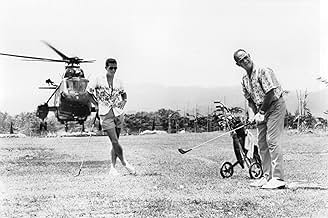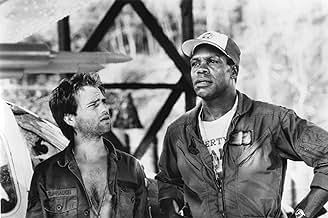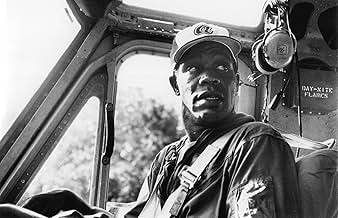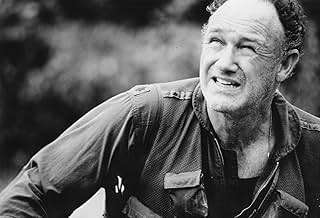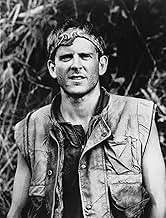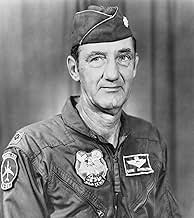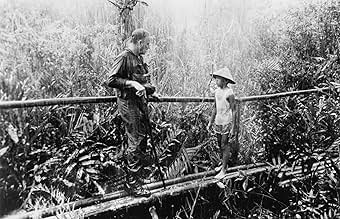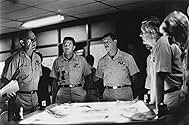IMDb-BEWERTUNG
6,5/10
10.292
IHRE BEWERTUNG
Füge eine Handlung in deiner Sprache hinzuDuring the Vietnam War, Colonel Hambleton's aircraft is shot down over enemy territory and a frantic rescue operation ensues.During the Vietnam War, Colonel Hambleton's aircraft is shot down over enemy territory and a frantic rescue operation ensues.During the Vietnam War, Colonel Hambleton's aircraft is shot down over enemy territory and a frantic rescue operation ensues.
- Auszeichnungen
- 1 Nominierung insgesamt
Michael Ng
- Vietnamese Man
- (as Rev. Michael Ng)
Stuart B. Hagen
- EB-66 Officer
- (as Stuart Hagen)
Jeffrey Baxter
- Helicopter Gunner
- (as Jeff Baxter)
Bonny Yong
- NVC
- (as Bonnie Yong)
- …
Empfohlene Bewertungen
To this day I am still amazed at how well Lt. Colonel Iceal Hambleton was able to formulate a plan on as we say in the military, "To Get the Hell out of Dodge".
This movie didn't rely on the most sophisticated special effects to make it good. It relied mainly on the two main characters to create a good dialog between them.
For any war buffs out there, this was a good movie to sit back and watch the some of the more unique tactics used to survive in bad situations.
This movie didn't rely on the most sophisticated special effects to make it good. It relied mainly on the two main characters to create a good dialog between them.
For any war buffs out there, this was a good movie to sit back and watch the some of the more unique tactics used to survive in bad situations.
Lt. Colonel Iceal Hambleton (Gene Hackman) is a respected, middle-aged strategist who has only seen the war from the air - and high in the air, too. During one reconnaissance mission, however, he's shot down behind enemy lines for the first time. Scared and out of his element, Hambleton must rely on Captain Clark (Danny Glover), a pilot, to help him keep his composure until a rescue can happen.
Most of the scenes are of just the two leads, almost making this a two-character action play. Both men provide stellar performances, with Hackman putting a decidedly different spin on his tough-guy, in-control persona. Glover is equally aces as the tireless pilot. And just in case you think there's going to be more talk than action in this movie, don't fret. The Vietcong are around somewhere, and they know Hambleton's in the vicinity. Not only does Clark have to get Hambleton out of there before good ol' Charlie finds him, he has to get him out of there before U.S. forces carpet-bomb the entire area! Needless to say, there are bombs bursting galore. Jerry Reed, who plays Clark's commander, also turns in a fine performance - a bit above par for Reed - and served as executive producer and composed some of the songs on the soundtrack.
Most of the scenes are of just the two leads, almost making this a two-character action play. Both men provide stellar performances, with Hackman putting a decidedly different spin on his tough-guy, in-control persona. Glover is equally aces as the tireless pilot. And just in case you think there's going to be more talk than action in this movie, don't fret. The Vietcong are around somewhere, and they know Hambleton's in the vicinity. Not only does Clark have to get Hambleton out of there before good ol' Charlie finds him, he has to get him out of there before U.S. forces carpet-bomb the entire area! Needless to say, there are bombs bursting galore. Jerry Reed, who plays Clark's commander, also turns in a fine performance - a bit above par for Reed - and served as executive producer and composed some of the songs on the soundtrack.
In 1969/70 I was a US Army Huey pilot in Northern I Corps of South Vietnam. I was on Hamburger Hill in the A Shau valley, flew in Laos and some in North Vietnam. BAT 21 is the first Vietnam War movie I have ever seen.
The truth of the war and how it was done and flown is terrible enough. This movie is way off the mark as to who flew aircraft and how they were flown.
When the UH-1N was in a left turn the the camera man made a shot out the left door showing the ground and the shadow of the aircraft, the shadow was a Bell Jet Ranger! Very poor quality. Of course the UH-1N was really a Bell 212, just look at the tail rotor. I have over 4,000 hours of helicopter time, 886 hours of which is in combat.
This movie cheapened everyone in the war, I would assume it is the norm rather than the exception.
From what I have read about the real Bat 21 I would say that truth is more interesting, shocking and horrible that this 10th rate film.
Jimmy L. Ratcliff former US Army Chief Warrant Officer
The truth of the war and how it was done and flown is terrible enough. This movie is way off the mark as to who flew aircraft and how they were flown.
When the UH-1N was in a left turn the the camera man made a shot out the left door showing the ground and the shadow of the aircraft, the shadow was a Bell Jet Ranger! Very poor quality. Of course the UH-1N was really a Bell 212, just look at the tail rotor. I have over 4,000 hours of helicopter time, 886 hours of which is in combat.
This movie cheapened everyone in the war, I would assume it is the norm rather than the exception.
From what I have read about the real Bat 21 I would say that truth is more interesting, shocking and horrible that this 10th rate film.
Jimmy L. Ratcliff former US Army Chief Warrant Officer
It would have been easy to turn a story like this into a cheap action flick -- heroic downed USAF Colonel fights his way through enemy territory with help of heroic self-sacrificing black pilot.
It doesn't happen, exactly. The story, as I understand it, is based on fact, but I don't know how much of it is factual. Maybe the evacuation pilot, Danny Glover, really DID take off alone in a helicopter (in which he was not qualified), rescue Colonel Hambledon (Gene Hackman) single-handedly, successfully crash the helicopter he was not qualified in, and maybe the two of them then escape a horde of North Vietnamese pursuers during a "carpet bombing" of the whole area, with Glover sustaining one of those nasty but not unphotogenic shoulder wounds in the process. Maybe it IS true but it sounds a lot like rather routine fiction to me because real life is seldom so tidy. I can believe the part that golf plays in the escape plan. It's so absurd that no writer in his right mind would dream it up.
Still -- that having been said -- this is a truly worthwhile movie. Action fans will find lots of exploding fireballs if that's what they're looking for. There will also be wounded smoking helicopters spinning drunkenly downward and a man being blown up in a minefield.
But that's not what makes the movie important. The action is usually nothing more than a means to an end. In this case, the end is the education and humanization of Colonel Iceal Hambledon, USAF.
He's your normal military men, an expert on electronic countermeasures. He is 53 years old and has spent most of his life in the military. He's never seen combat. And his being shot down constitutes his introduction to what the film shows us is a pretty ugly kind of business.
Behind enemy lines he spies a column of NV troops and vehicles and calls in an air strike. Boom. Afterward the NVA shoot one of their own wounded troops, which Hambledon finds nasty. Before he knows it, stumbling through the bush, he finds an empty hootch. While scavenging it for food and water, he is discovered by its owner. Neither man understands the other's language. A physical fight follows which Hambledon can only escape from my shooting and killing the Vietnamese farmer. The farmer's napalm-scarred family show up and rush sobbing to the dead body while Hambledon backs away, stunned, saying stupidly, "I'm sorry. I'm sorry." There follows a scene in which captured American fliers sacrifice themselves to save Hambledon and the Air Force then demolishes the nearby village full of soldiers and women and children. "Everywhere I go, people die," Hambledon comments sadly to himself. (I can't emphasize too strongly how much tragedy Hackman invests his lines with. They emerge as more than simply lines of dialogue. He's a fine, reliable, unflamboyant performer.) Hambledon vows that he's all done killing people -- and he is, even when he has to opportunity to shoot an armed enemy soldier who is chasing him. The Vietnames is disoriented, twirling about dizzily while a garden of slow motion flame sprouts around him. Hambledon has a bead on him but then shakes his head in disgust and looks away without firing.
Danny Glover is good too. As an actor he may have more range than he's usually given credit for. Here, as in the "Lethal Weapon" movies, he's more of a supportive sidekick than anything else. He's the guy on the other end of the line who is there when you must spill your emotions to SOMEONE. Not that he's given trite lines in the part. Hambledon hesitates at one point, then tell him over the radio, "I killed a man today." "Roger that," says Glover. He understands what Hambledon's getting at -- but what is there to say? It's combat, not Oprah Winfrey. Also, anyone who wants to see Glover demonstrate that range might want to check out "Switchback," in which he is a good-natured, avuncular, laid-back serial killer.
Sometimes I wonder if some of us have forgotten just how lousy an experience war is for everyone involved -- for us, for our opponents, and for the civilians drawn willy nilly into it. This film is a decent reminder.
It doesn't happen, exactly. The story, as I understand it, is based on fact, but I don't know how much of it is factual. Maybe the evacuation pilot, Danny Glover, really DID take off alone in a helicopter (in which he was not qualified), rescue Colonel Hambledon (Gene Hackman) single-handedly, successfully crash the helicopter he was not qualified in, and maybe the two of them then escape a horde of North Vietnamese pursuers during a "carpet bombing" of the whole area, with Glover sustaining one of those nasty but not unphotogenic shoulder wounds in the process. Maybe it IS true but it sounds a lot like rather routine fiction to me because real life is seldom so tidy. I can believe the part that golf plays in the escape plan. It's so absurd that no writer in his right mind would dream it up.
Still -- that having been said -- this is a truly worthwhile movie. Action fans will find lots of exploding fireballs if that's what they're looking for. There will also be wounded smoking helicopters spinning drunkenly downward and a man being blown up in a minefield.
But that's not what makes the movie important. The action is usually nothing more than a means to an end. In this case, the end is the education and humanization of Colonel Iceal Hambledon, USAF.
He's your normal military men, an expert on electronic countermeasures. He is 53 years old and has spent most of his life in the military. He's never seen combat. And his being shot down constitutes his introduction to what the film shows us is a pretty ugly kind of business.
Behind enemy lines he spies a column of NV troops and vehicles and calls in an air strike. Boom. Afterward the NVA shoot one of their own wounded troops, which Hambledon finds nasty. Before he knows it, stumbling through the bush, he finds an empty hootch. While scavenging it for food and water, he is discovered by its owner. Neither man understands the other's language. A physical fight follows which Hambledon can only escape from my shooting and killing the Vietnamese farmer. The farmer's napalm-scarred family show up and rush sobbing to the dead body while Hambledon backs away, stunned, saying stupidly, "I'm sorry. I'm sorry." There follows a scene in which captured American fliers sacrifice themselves to save Hambledon and the Air Force then demolishes the nearby village full of soldiers and women and children. "Everywhere I go, people die," Hambledon comments sadly to himself. (I can't emphasize too strongly how much tragedy Hackman invests his lines with. They emerge as more than simply lines of dialogue. He's a fine, reliable, unflamboyant performer.) Hambledon vows that he's all done killing people -- and he is, even when he has to opportunity to shoot an armed enemy soldier who is chasing him. The Vietnames is disoriented, twirling about dizzily while a garden of slow motion flame sprouts around him. Hambledon has a bead on him but then shakes his head in disgust and looks away without firing.
Danny Glover is good too. As an actor he may have more range than he's usually given credit for. Here, as in the "Lethal Weapon" movies, he's more of a supportive sidekick than anything else. He's the guy on the other end of the line who is there when you must spill your emotions to SOMEONE. Not that he's given trite lines in the part. Hambledon hesitates at one point, then tell him over the radio, "I killed a man today." "Roger that," says Glover. He understands what Hambledon's getting at -- but what is there to say? It's combat, not Oprah Winfrey. Also, anyone who wants to see Glover demonstrate that range might want to check out "Switchback," in which he is a good-natured, avuncular, laid-back serial killer.
Sometimes I wonder if some of us have forgotten just how lousy an experience war is for everyone involved -- for us, for our opponents, and for the civilians drawn willy nilly into it. This film is a decent reminder.
Never saw this film when it was released originally in 1988. Not knowing what to expect, we decided to take a chance watching it on cable when it was shown the other night; it was a complete surprise. Director Peter Markle, working with a magnificent cast, headed by Gene Hackman and Danny Glover, does wonders to recreate this story of valor under the worst possible circumstances.
The cinematography is excellent. The film relies on visual effects, that are not to be confused with the incredible special effects that we have seen in other movies. Yes, of course, we all know that they are special, but the movie relies in the interplay between the missing Col. Hambleton on the ground and Capt. "Bird Dog" Clark who had the courage to stay focused, first in his plane, and later in the helicopter as he searches for this man, who he didn't even know.
It's a tribute that these two military men in caring for one another in a difficult situation. Gene Hackman is an actor that always project convincing character. His take on the colonel is the real thing. Danny Glover, on the other hand, is on target. He demonstrates he has what it takes to hold it against big stars, like Mr. Hackman, or in his films with Mel Gibson. He is a joy to watch in his portrayal of a man who is an honest professional.
For fans of action war movies, this is a more real approach to the genre thanks to the vision of its director Peter Markle.
The cinematography is excellent. The film relies on visual effects, that are not to be confused with the incredible special effects that we have seen in other movies. Yes, of course, we all know that they are special, but the movie relies in the interplay between the missing Col. Hambleton on the ground and Capt. "Bird Dog" Clark who had the courage to stay focused, first in his plane, and later in the helicopter as he searches for this man, who he didn't even know.
It's a tribute that these two military men in caring for one another in a difficult situation. Gene Hackman is an actor that always project convincing character. His take on the colonel is the real thing. Danny Glover, on the other hand, is on target. He demonstrates he has what it takes to hold it against big stars, like Mr. Hackman, or in his films with Mel Gibson. He is a joy to watch in his portrayal of a man who is an honest professional.
For fans of action war movies, this is a more real approach to the genre thanks to the vision of its director Peter Markle.
Wusstest du schon
- WissenswertesAs a U.S. Air Force Lieutenant Colonel, "Gene" Hambleton commanded the 57first Missile Squadron at Davis-Monthan Air Force Base, from 1965 to 1971. He is better known as by his tactical radio call-sign, "Bat 21", he used in Vietnam when he was shot down in 1972, while jamming enemy radar, and parachuted behind enemy lines. When on the ground, Colonel Hambleton found himself in the midst of an invasion force of over thirty thousand North Vietnamese troops. While evading capture for eleven days, he used his survival radio to call in air strikes against the invasion force. Rescue crews gave him coded instructions for where to go to be rescued, based on golf courses, on which he had played, at different Air Force bases. Hambleton's harrowing ordeal was recounted in the book Bat 21 (1980), which was made into this movie. He died from cancer on September 19, 2004 at age 85.
- PatzerIn the movie, the aircraft flown by "Bird Dog" was not actually a Cessna O-2 observation aircraft, but was a civilian Cessna 337 Skymaster, painted gray. An O-2 would have multiple windows in the doors and floor to allow visibility of the ground.
- Zitate
Capt. Bartholomew Clark: Let's get the basic relationship down... I'm the lifeguard, you're the drowning man. If you relax, I can bring you to shore. If you fight me, then I'll have to slap you around.
- VerbindungenEdited into Stealth Fighter (1999)
Top-Auswahl
Melde dich zum Bewerten an und greife auf die Watchlist für personalisierte Empfehlungen zu.
- How long is Bat*21?Powered by Alexa
Details
- Erscheinungsdatum
- Herkunftsland
- Offizieller Standort
- Sprache
- Auch bekannt als
- Regreso del infierno
- Drehorte
- Produktionsfirmen
- Weitere beteiligte Unternehmen bei IMDbPro anzeigen
Box Office
- Bruttoertrag in den USA und Kanada
- 3.966.256 $
- Eröffnungswochenende in den USA und in Kanada
- 982.080 $
- 23. Okt. 1988
- Weltweiter Bruttoertrag
- 3.966.256 $
- Laufzeit1 Stunde 45 Minuten
- Farbe
- Sound-Mix
- Seitenverhältnis
- 1.85 : 1
Zu dieser Seite beitragen
Bearbeitung vorschlagen oder fehlenden Inhalt hinzufügen

Oberste Lücke
By what name was BAT21 - Mitten im Feuer (1988) officially released in India in English?
Antwort

